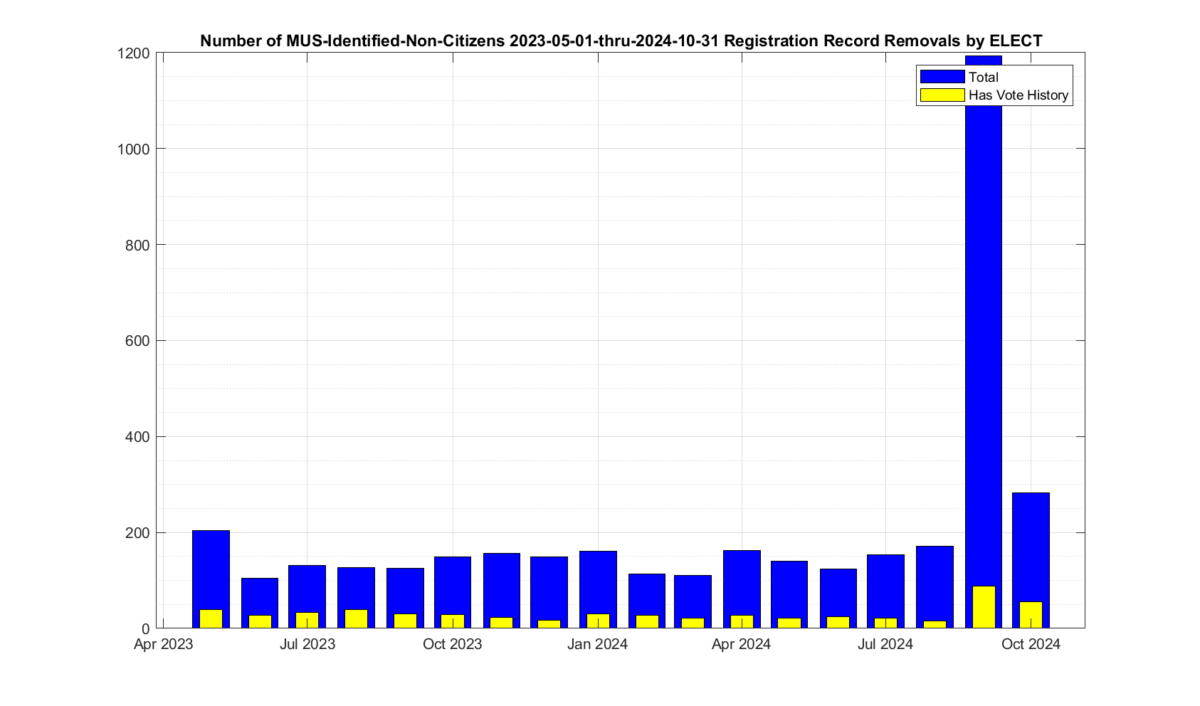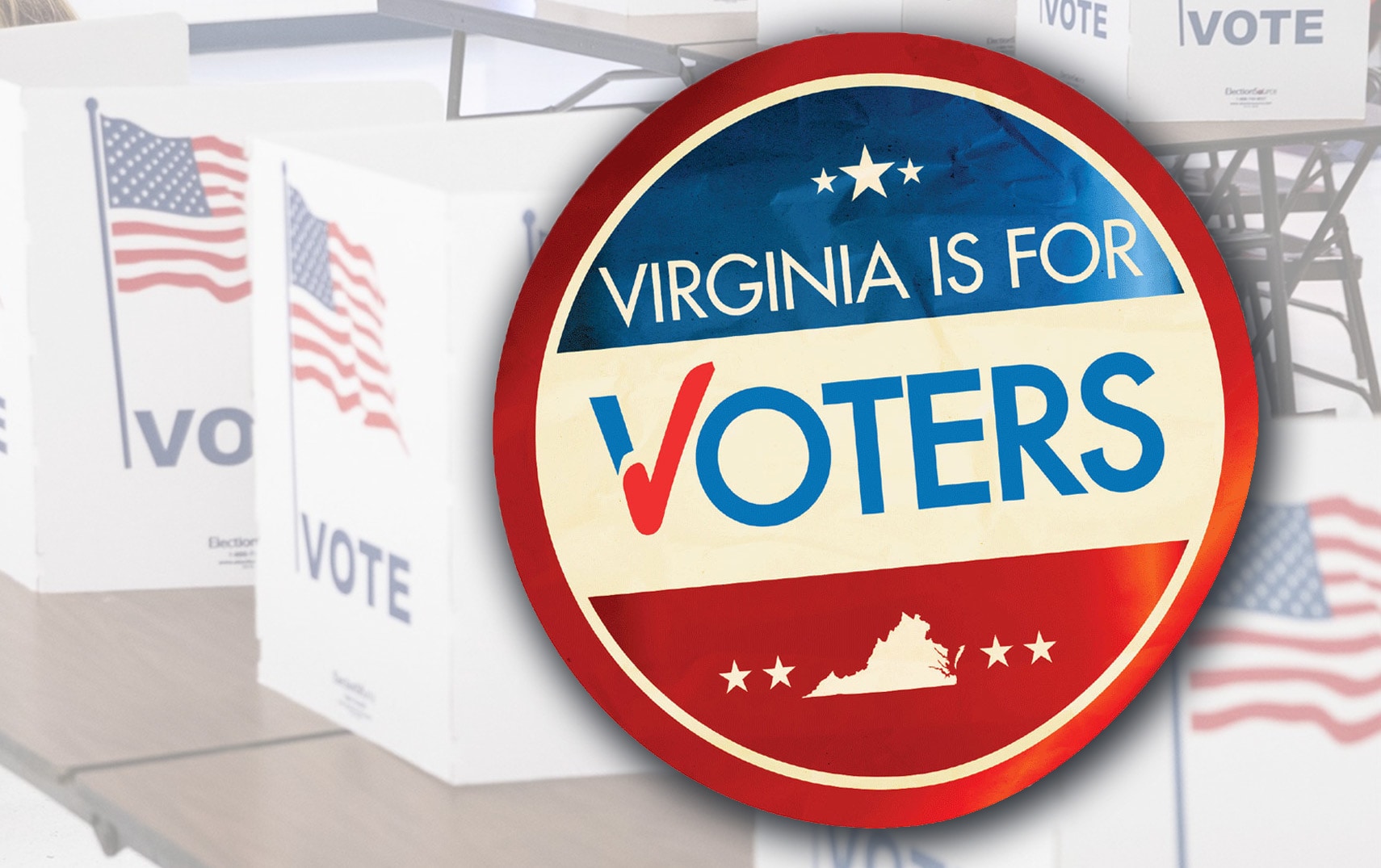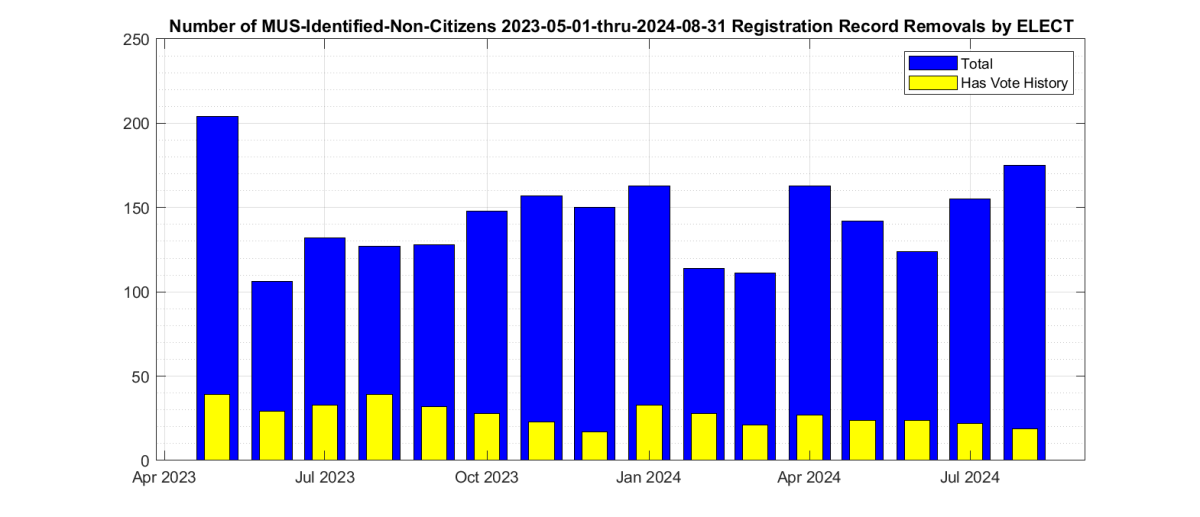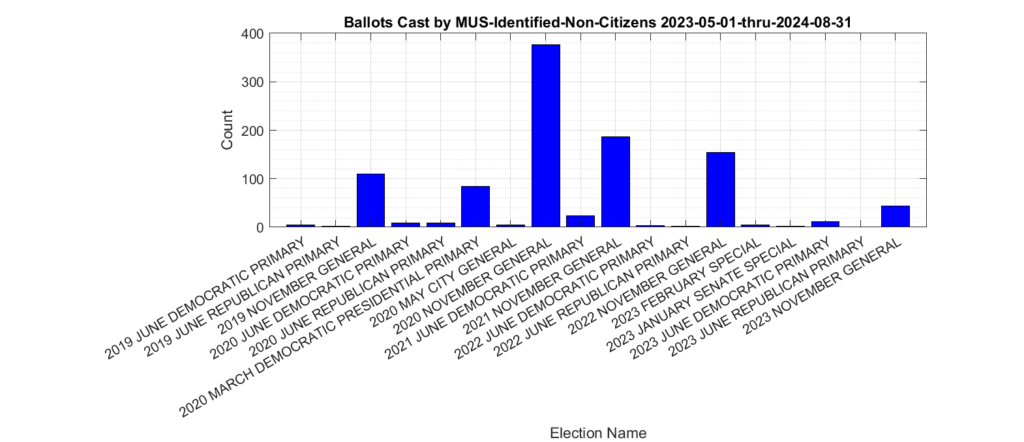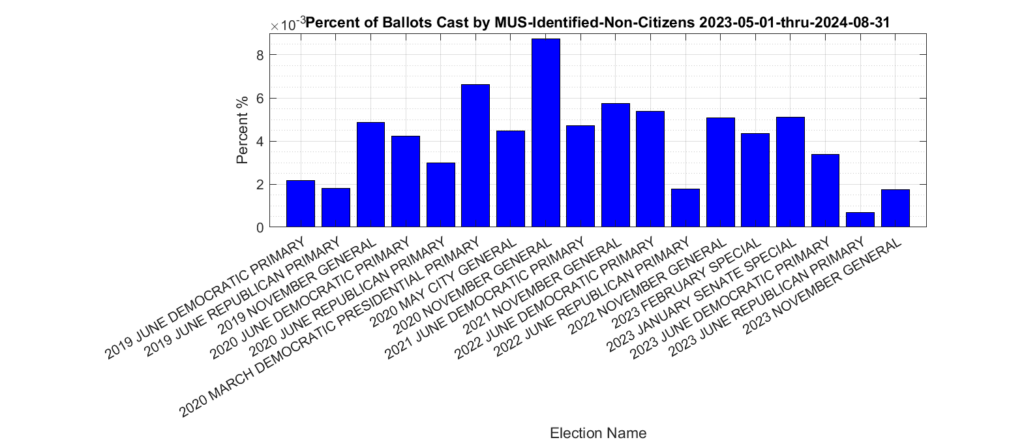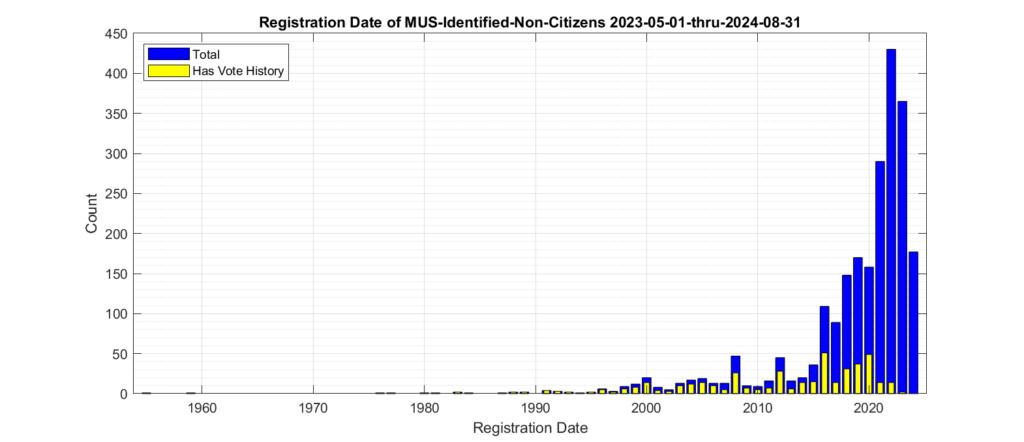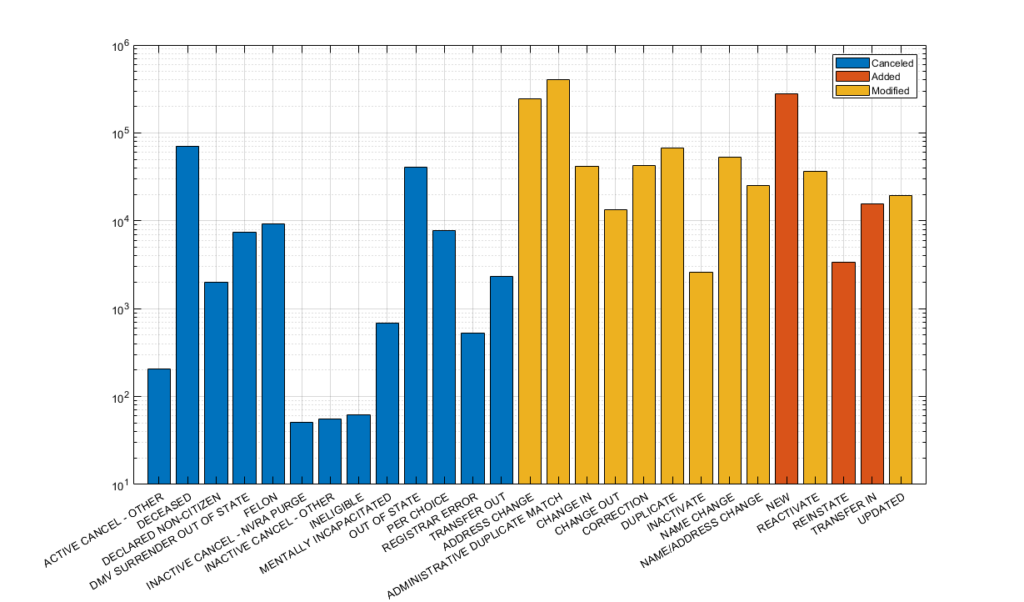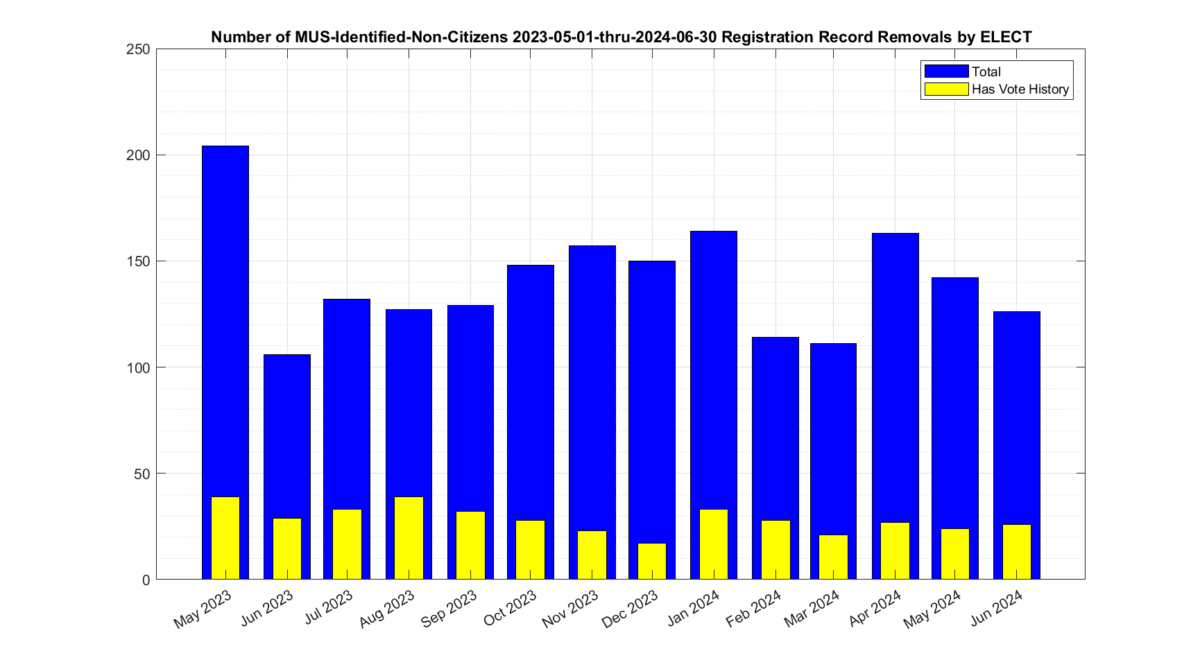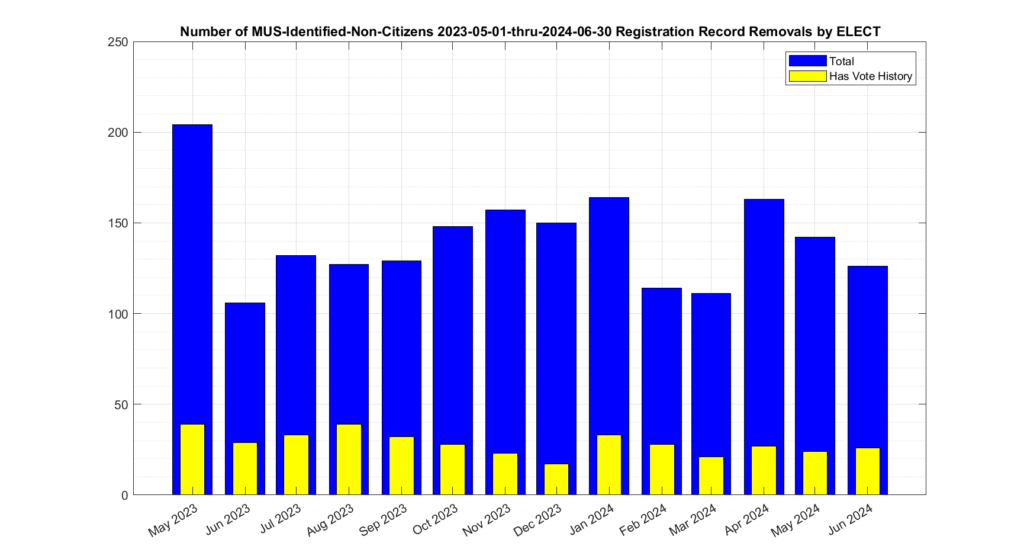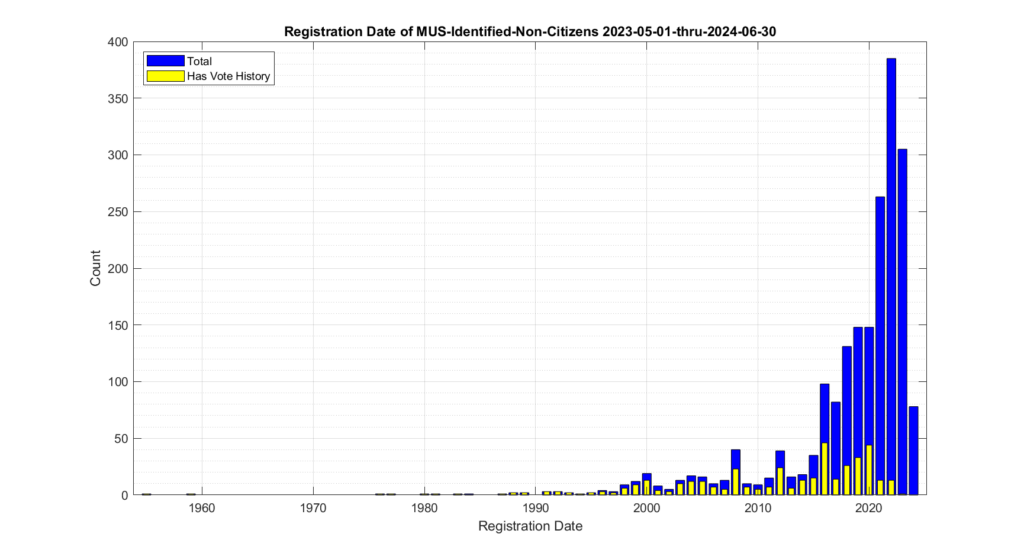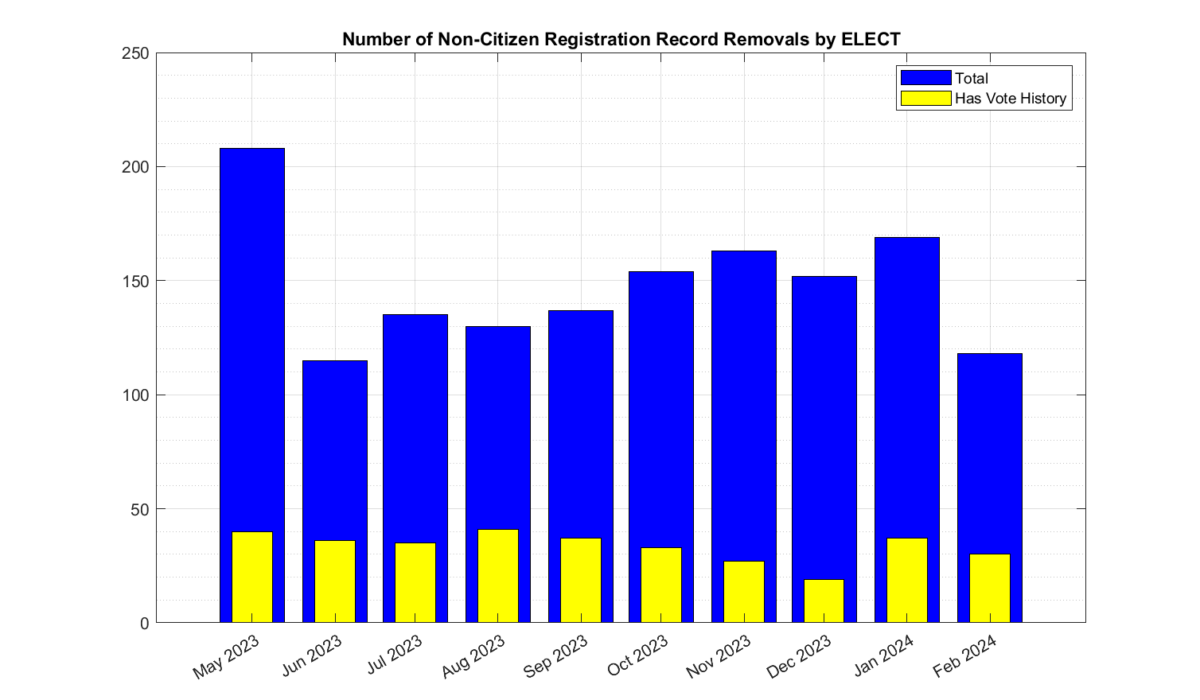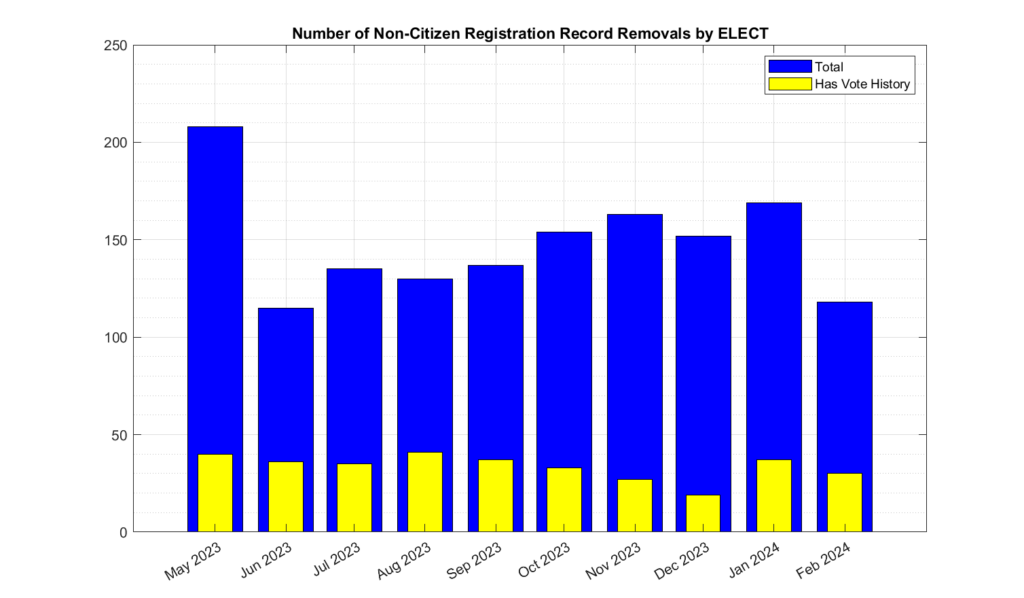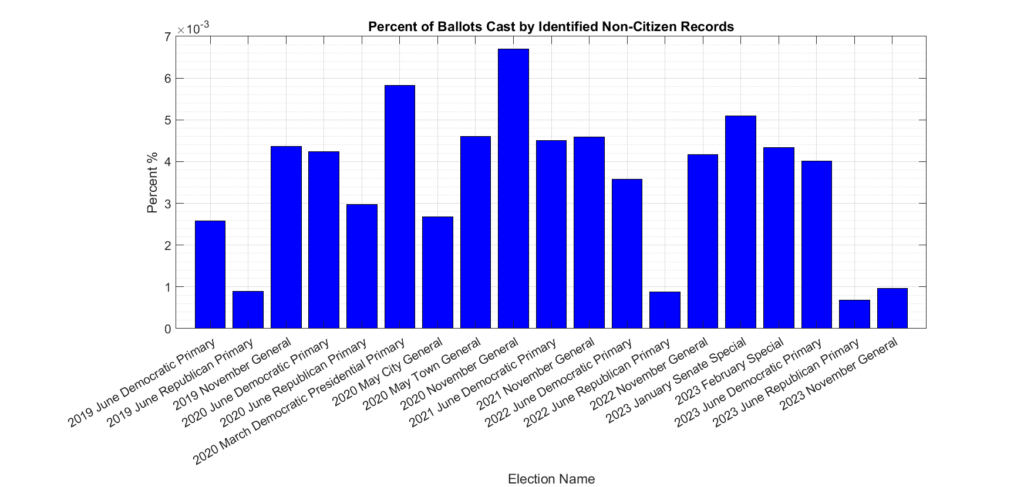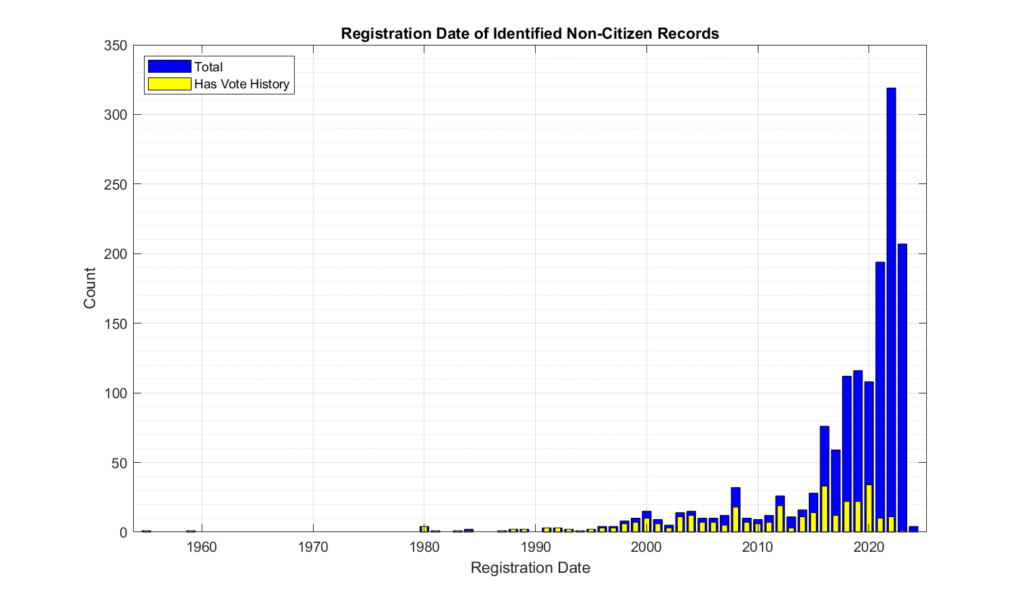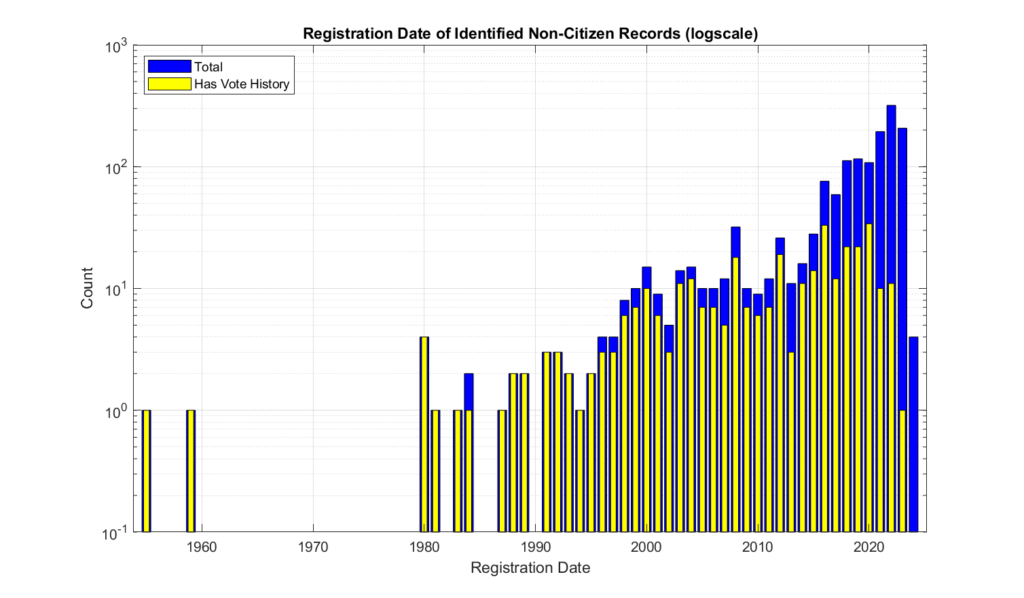We have updated our previous analysis (from March, July, Sept and Oct) with the latest information from the VA Department of Elections data.
Abstract:
Using the data provided by the VA Department of Elections (ELECT), we have identified at least 3,761 unique registrations that were self-identified as “Declared Non-Citizen” and removed by ELECT from the voter rolls since May of 2023. Of those 3,761 removals there were 569 that also had corresponding records of recent ballots cast at some point in the official Voter History record that we could observe. There were 1,333 associated ballots cast identified since Feb of 2019. There were an additional 2 non-citizen registrations and ballots as per the Daily Absentee List (DAL) data, that were not contained in the Voter History data. The total number of identified non-citizen ballots cast is therefore 1,335 by 539 registrants when combining unique VHL and DAL identifications.
Note that there was a large spike (see Figure 1) in declared non-citizen removals in Sept that seems to have returned to the norm in October. We do not receive enough information from VA ELECT in order to determine if this spike is due to simply increased interactions and interest in the 2024 general election, or changes in the procedures by ELECT, etc. But we can observe this change in the data, even though we do not have enough information as to make a hypothesis as to why it is present.
After our March 2024 post on this topic, we submitted all of the relevant information that we had at the time to the VA AG’s office. We have not heard any response or update on the matter since that time, besides this being considered an active investigation. We subsequently sent our July results as well to the same contact at the AG’s office, but have had no response.
The Arlington County VA Electoral Board undertook their own investigation into this matter after our previous results were posted, and they recently (as of Sept 10 2024) voted 3-0 to send the information to the AG’s office as well. The Arlington County Commonwealths Attorney also is reported to have an ongoing investigation into the matter. Similar efforts are underway in multiple other counties, including Loudoun and Fairfax counties, to name a few.
In October the League of Women Voters along with the US DOJ sued VA over this issue and attempted to get an injunction to place ~1,600 of these removed registrations back on the Voter roll. After two lower courts granted the injunction, it was stayed by the US Supreme Court.
It is EPEC’s opinion that the State of VA is correctly applying the law in this matter, as I detailed in a X.com post on Oct 12, but we will be closely watching how this case continues to play out as we move forward.
Background:
The VA Department of Elections continuously tries to identify and remove invalid or out of date registration records from the voter rolls. One category used for removal is if a registrant has been determined to be a non-citizen. It is required by the VA Constitution that only citizens are allowed to vote in VA elections.
In elections by the people, the qualifications of voters shall be as follows: Each voter shall be a citizen of the United States, shall be eighteen years of age, shall fulfill the residence requirements set forth in this section, and shall be registered to vote pursuant to this article. …
VA Constitution, Article II, Section 1. https://law.lis.virginia.gov/constitution/article2/section1/
Additionally, according to VA Code Section 24.2-1004, the act of knowingly casting a ballot by someone who is not eligible to vote is a Class 6 felony.
A. Any person who wrongfully deposits a ballot in the ballot container or casts a vote on any voting equipment, is guilty of a Class 1 misdemeanor.
B. Any person who intentionally (i) votes more than once in the same election, whether those votes are cast in Virginia or in Virginia and any other state or territory of the United States, (ii) procures, assists, or induces another to vote more than once in the same election, whether those votes are cast in Virginia or in Virginia and any other state or territory of the United States, (iii) votes knowing that he is not qualified to vote where and when the vote is to be given, or (iv) procures, assists, or induces another to vote knowing that such person is not qualified to vote where and when the vote is to be given is guilty of a Class 6 felony.
https://law.lis.virginia.gov/vacode/title24.2/chapter10/section24.2-1004/
ELECT makes available for purchase by qualifying parties various different data sets, including the registered voter list (RVL) and the voter history list information file (VHL). Additionally, ELECT makes available a Monthly Update Service (MUS) subscription that is published at the beginning of each month and contains (almost) all of the Voter List changes and transactions for the previous period.
In the MUS data there is a “NVRAReasonCode” field that is associated with each transaction that gives the reason for the update or change in the voter record. This is in accordance with the disclosure and transparency requirements in the NVRA. One of the possible reason codes given for records that are removed is “Declared Non-Citizen.”
EPEC has been consistently purchasing and archiving all of these official records as part of our ongoing work to document and educate the public as to the ongoing operations of our elections. (If your interested in supporting this work, please head on over to our donation page, or to our give-send-go campaign to make a tax-deductible donation, as these data purchases are not cheap!)
EPEC looked at the number of records associated with unique voter identification numbers that had been identified for removal from the voter record due to non-citizenship status, per the entries in the MUS, and correlated those results with our accumulated voter history list information in order to determine how many non-citizen registrations had corresponding records of ballots cast in previous elections. We only considered those records that are currently in a non-active state as of the latest MUS transaction log, as some determinations of non-citizenship status in the historical MUS transaction log might have been due to error and subsequently corrected and reinstated to active status. That is, we are not considering those records that had a “Declared Non-Citizen” disqualification, but were then subsequently reinstated and reactivated by ELECT.
While EPEC has periodically purchased full copies of the Voter History List for our archive, there is a known issue with the way ELECT handles removals from the voter record that can cause sampling issues depending on the time the VHL file is purchased, and records of legitimately cast ballots to not be present in the VHL: Namely, when ELECT removes a voter from the voter list, they also remove all instances of that voter ID from voter history information and other data files provided to qualified organizations. (IMO … thats a terrible way to manage the data, but that is the way it is done.) In light of that, EPEC also used its archived versions of the Daily Absentee List (DAL) for recent elections in order to attempt to find records of votes cast that might otherwise be missing from the VHL.
Results:
There were 3,761 unique voter records marked for removal with the reason of “Declared Non-Citizen” and not subsequently reinstated in the accumulated MUS record that EPEC began collecting in mid-2023. Of those 3,761 there were 569 that also had corresponding records of recent ballots cast at some point in the official Voter History record that we could observe. There were 1,333 associated ballots cast identified since Feb of 2019. Figure 1 shows the distribution of non-citizen voters in the cumulative MUS file history. The blue trace represent the total identified and CANCELED non-citizen registrations, and the yellow trace represents the number of those records that also had corresponding records in the accumulated voter history data.
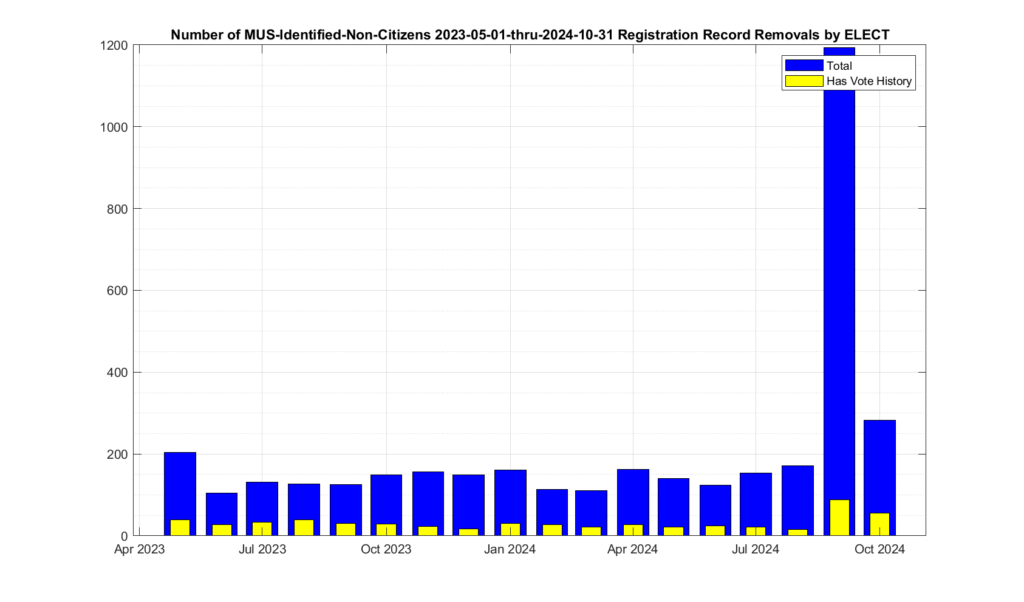
Note that the data contained in the MUS updates often covers more than a single month period. In other words, the individual MUS files are oversampled. Subsequent MUS files can therefore also have repeated entries from previous versions, as their data may overlap. Our analysis used the first unique entry for a given voter ID marked as “Declared Non-Citizen” in the cumulative MUS record in order to build Figure 1. This data oversampling in the MUS helps explain the relative increase in the May 2023 bin.
As VHL information can be incomplete depending on the time the VHL data was purchased in relation to the time that registrants were removed from voter records, EPEC also checked these non-citizen removals against the archived history of Daily Absentee List (DAL) files that EPEC has accumulated. There were an additional 2 non-citizen registrations and ballots as per the Daily Absentee List (DAL) data, that were not contained in the Voter History data. The total number of identified non-citizen ballots cast is therefore 1,335 by 539 registrants when combining unique VHL and DAL identifications.
These identifications represent only the individuals who declared themselves as non-citizen status through official interactions with ELECT, DMV, or other agencies. Each removed registrant was then contacted by the registrar to confirm their non-citizen status.
The distribution of identified unique voter ID’s for the 569 identified non-citizen voters per VA locality is given below in Table 1. It should be noted that each ballot record has a specific locality associated with where the ballot was cast, whereas unique individuals might move between localities over time. The assignment of unique identified individuals to each locality in table 1 is therefore based on the locality listed in the specific MUS “Declared Non-Citizen” record for that individual, while the assignment of ballot cast to Localities is based on the individual VHL/DAL records. A person could have lived and voted multiple times in one county, then moved to another county and voted again before finally being determined as a non-citizen. The same person would have generated multiple VHL/DAL records for each ballot cast, and associated with potentially different localities. This should be kept in mind when attempting to interpret Table 1.
| Removed | Voted per VHL | Votes per VHL | |
| ACCOMACK COUNTY | 7 | ||
| ALBEMARLE COUNTY | 45 | 8 | 14 |
| ALEXANDRIA CITY | 169 | 23 | 39 |
| AMELIA COUNTY | 2 | 1 | 3 |
| AMHERST COUNTY | 1 | ||
| APPOMATTOX COUNTY | 1 | ||
| ARLINGTON COUNTY | 113 | 19 | 52 |
| AUGUSTA COUNTY | 15 | 3 | 3 |
| BEDFORD COUNTY | 11 | 2 | 4 |
| BOTETOURT COUNTY | 2 | ||
| BRISTOL CITY | 1 | ||
| BRUNSWICK COUNTY | 2 | 1 | 2 |
| BUCKINGHAM COUNTY | 3 | ||
| CAROLINE COUNTY | 9 | 3 | 10 |
| CARROLL COUNTY | 8 | 2 | 5 |
| CHARLES CITY COUNTY | 2 | 1 | 3 |
| CHARLOTTESVILLE CITY | 25 | 2 | 7 |
| CHESAPEAKE CITY | 96 | 23 | 56 |
| CHESTERFIELD COUNTY | 237 | 26 | 54 |
| CLARKE COUNTY | 8 | 3 | 4 |
| COLONIAL HEIGHTS CITY | 12 | 1 | 3 |
| COVINGTON CITY | 2 | ||
| CRAIG COUNTY | 1 | ||
| CULPEPER COUNTY | 27 | 2 | 2 |
| DANVILLE CITY | 18 | 2 | 8 |
| DICKENSON COUNTY | 1 | 1 | |
| DINWIDDIE COUNTY | 9 | 1 | |
| EMPORIA CITY | 2 | ||
| ESSEX COUNTY | 3 | 1 | 3 |
| FAIRFAX CITY | 9 | 3 | 13 |
| FAIRFAX COUNTY | 678 | 104 | 229 |
| FAUQUIER COUNTY | 24 | 3 | 10 |
| FLUVANNA COUNTY | 3 | 2 | 2 |
| FRANKLIN COUNTY | 2 | 1 | 1 |
| FREDERICK COUNTY | 30 | 2 | 2 |
| FREDERICKSBURG CITY | 23 | 2 | 4 |
| GALAX CITY | 2 | ||
| GILES COUNTY | 2 | ||
| GLOUCESTER COUNTY | 2 | 1 | 1 |
| GOOCHLAND COUNTY | 5 | ||
| GRAYSON COUNTY | 1 | ||
| GREENE COUNTY | 6 | 1 | 2 |
| HALIFAX COUNTY | 1 | ||
| HAMPTON CITY | 59 | 11 | 13 |
| HANOVER COUNTY | 14 | 2 | 6 |
| HARRISONBURG CITY | 84 | 5 | 6 |
| HENRICO COUNTY | 79 | 3 | 14 |
| HENRY COUNTY | 2 | ||
| ISLE OF WIGHT COUNTY | 1 | 2 | |
| JAMES CITY COUNTY | 31 | 4 | 13 |
| KING GEORGE COUNTY | 5 | ||
| KING WILLIAM COUNTY | 1 | ||
| LOUDOUN COUNTY | 235 | 52 | 114 |
| LOUISA COUNTY | 9 | ||
| LYNCHBURG CITY | 23 | 3 | 4 |
| MANASSAS CITY | 51 | 4 | 11 |
| MANASSAS PARK CITY | 18 | 1 | 5 |
| MARTINSVILLE CITY | 6 | 1 | |
| MECKLENBURG COUNTY | 7 | 3 | 10 |
| MIDDLESEX COUNTY | 2 | ||
| MONTGOMERY COUNTY | 3 | ||
| NELSON COUNTY | 2 | ||
| NEW KENT COUNTY | 3 | 1 | |
| NEWPORT NEWS CITY | 110 | 23 | 51 |
| NORFOLK CITY | 94 | 13 | 33 |
| NORTHAMPTON COUNTY | 1 | 1 | |
| NORTHUMBERLAND COUNTY | 3 | 2 | 5 |
| NORTON CITY | 1 | ||
| NOTTOWAY COUNTY | 4 | ||
| ORANGE COUNTY | 3 | 1 | 3 |
| PATRICK COUNTY | 1 | ||
| PETERSBURG CITY | 28 | 3 | 9 |
| PITTSYLVANIA COUNTY | 7 | 2 | 4 |
| PORTSMOUTH CITY | 44 | 13 | 38 |
| POWHATAN COUNTY | 3 | 1 | |
| PRINCE EDWARD COUNTY | 10 | 3 | 11 |
| PRINCE GEORGE COUNTY | 12 | ||
| PRINCE WILLIAM COUNTY | 414 | 61 | 139 |
| PULASKI COUNTY | 6 | 1 | 2 |
| RAPPAHANNOCK COUNTY | 2 | ||
| RICHMOND CITY | 172 | 25 | 66 |
| ROANOKE CITY | 73 | 4 | 2 |
| ROANOKE COUNTY | 19 | 2 | 3 |
| 1 | |||
| ROCKINGHAM COUNTY | 22 | 5 | 13 |
| RUSSELL COUNTY | 3 | 1 | 1 |
| SALEM CITY | 3 | ||
| SCOTT COUNTY | 1 | 1 | 4 |
| SHENANDOAH COUNTY | 19 | 2 | 6 |
| SMYTH COUNTY | 2 | ||
| SPOTSYLVANIA COUNTY | 65 | 4 | 10 |
| STAFFORD COUNTY | 92 | 14 | 29 |
| STAUNTON CITY | 4 | ||
| SUFFOLK CITY | 39 | 14 | 31 |
| SURRY COUNTY | 1 | ||
| SUSSEX COUNTY | 2 | 1 | 3 |
| TAZEWELL COUNTY | 4 | 1 | 1 |
| VIRGINIA BEACH CITY | 164 | 21 | 70 |
| WARREN COUNTY | 14 | 2 | 5 |
| WASHINGTON COUNTY | 5 | 2 | 6 |
| WAYNESBORO CITY | 3 | ||
| WESTMORELAND COUNTY | 1 | ||
| WILLIAMSBURG CITY | 10 | 1 | |
| WINCHESTER CITY | 23 | 2 | 2 |
| WISE COUNTY | 2 | 1 | 2 |
| WYTHE COUNTY | 3 | ||
| YORK COUNTY | 22 | 11 | 41 |
| 3761 | 569 | 1333 |
The distribution of the 1,333 ballots that were identified as being cast by non-citizen voters (the yellow trace in Figure 1) in previous elections is shown in Figure 2. The most significant spikes are in the 2019, 2020, 2021 and 2022 November General elections, as well as the 2020 March Democratic presidential primary. Figure 3, which shows this distribution as a percentage of votes cast. Please note the scale of the Y-axis on the percent plot in Figure 3 is in percent of total ballots cast in each election. These graphs were only produced for the VHL data, and do not include the DAL identified records.
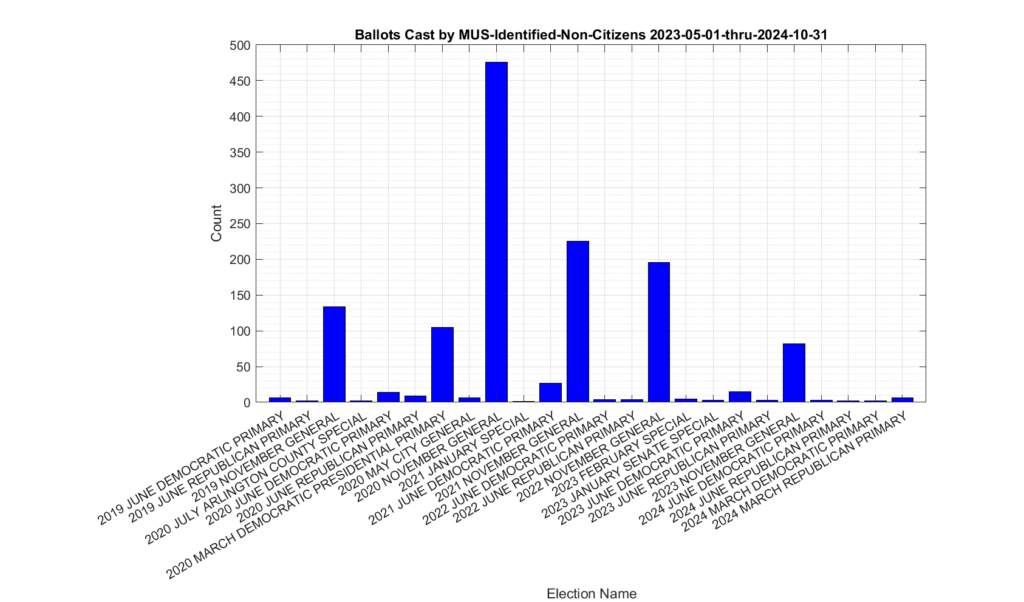
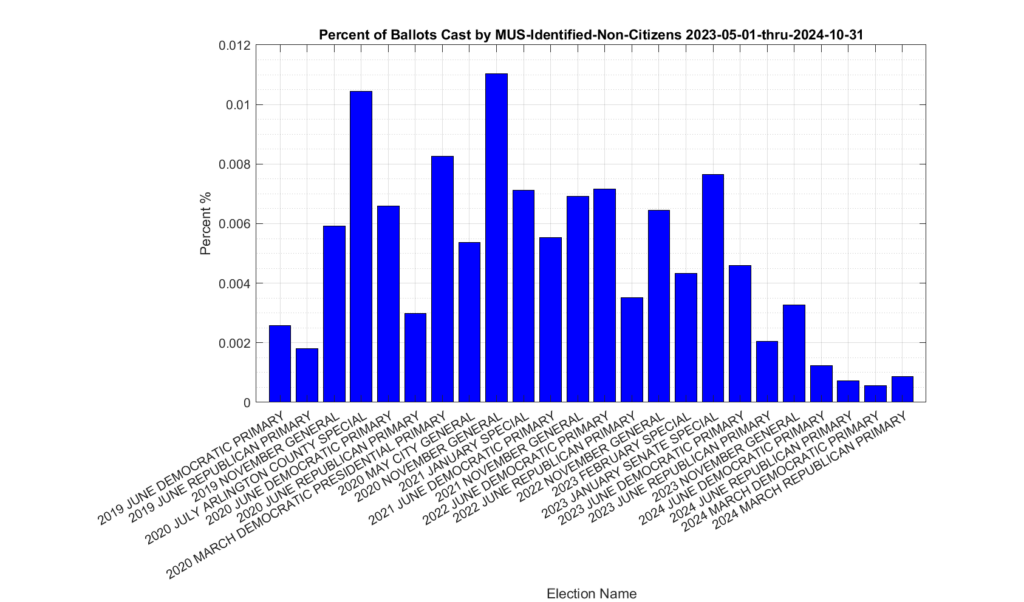
Figures 4 and 5 show the distribution of the registration dates of the identified non-citizen records. The same data is plotted in figure 4 and 5, with the only difference being the scale of the Y-axis in order to better observe the dynamic range of the values. When we look at the registration date of these identified records, we see that there is a distinct relative increase starting around 1996, and then again around 2012.
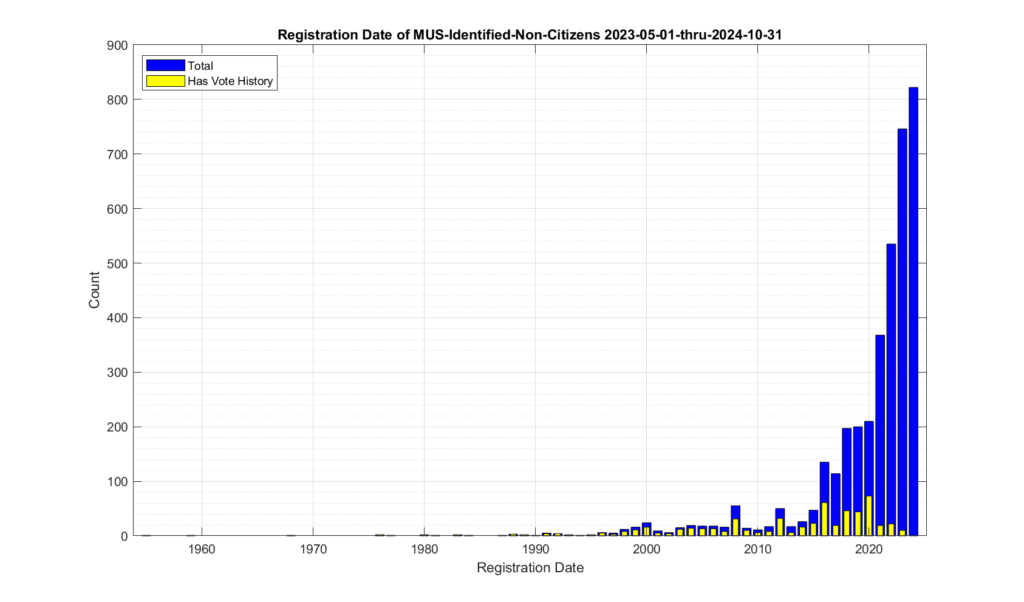
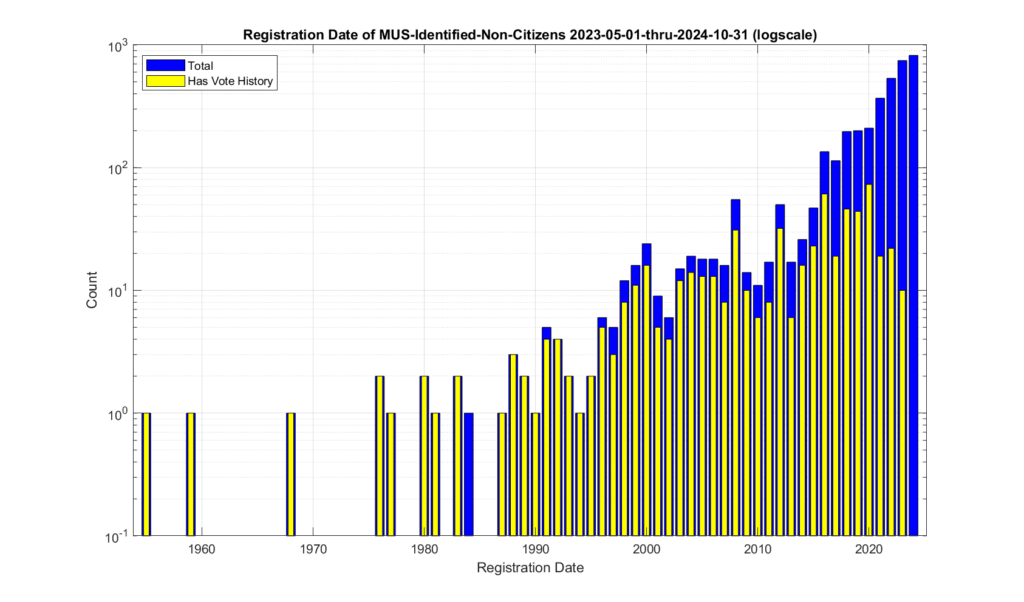
EPEC made a FOIA request to the VA Attorney General’s office on March 11, 2024 inquiring for any records regarding how many prosecutions for non-citizen voting had occurred since June of 2023. We received a response that the AG had no such relevant records.
EPEC subsequently submitted our March analysis dataset to the VA AG’s office upon their request. We have heard no updates or status as to any action taken by the AG’s office since that time, except that it is being considered an ongoing investigation.
Discussion
It appears from the MUS data, that the VA Department of Elections (ELECT) is doing routine identification, cleanup and removal of non-citizen registrations, which is a good thing and we commend them for their continued efforts to maintain clean voter registration lists.
Given the current court cases filed by LWV and DOJ against the state of VA on the matter, it is important to note that the records identified in the MUS are only those resulting from individuals self-identifying as a non-citizen via interactions with DMV, ELECT, or other official avenues.
The fact that a small number of these identified non-citizen registrations are also associated with (presumably … if the data from ELECT is accurate) illegally cast ballots in previous elections does raise a number of questions that citizens should be (politely) asking and discussing with their legislators, elected and appointed government officials. Each act of non-citizen voting is a de-facto disenfranchisement of legal voters rights, and is a punishable offense under VA law.
Q: How did these registrants get placed onto the voter rolls in the first place?
Q: What method and/or data sources are used by the state to identify non-citizen registrations for removal? If that process is exhaustive, and covers all registrations, then these numbers might be considered to represent a statistical complete picture of the problem. If that process is not exhaustive, in that it only uses serendipitous corroborating data sources, then these results likely under-represent the scale of the issues.
Q: As noted above, we are only considering here those individuals who have not had their records re-instated or reactivated after a determination of non-citizen status. We do not have enough information to determine how or why some records were first determined to be non-citizen, canceled and then subsequently re-instated. One potential area of concern is determining whether or not registrants might be falsely or errantly claiming to not be a citizen on official documents in order to be excused from jury duty, for example, and then work to re-instate their voting status once those documents percolate through the system to ELECT and are flagged for removal. This is a wholly separate but serious issue, as making false claims on official documents is itself a punishable offense.
Q: What procedures, processes and technical solutions are in place to prevent current or future registration and casting of ballots by non-citizens? This is especially pertinent given the current state of the flow of illegal immigrants crossing our national borders. According to a recent report by Yahoo Finance, VA is one of the top 30 destinations for illegal migrants, with both Loudoun County and Fairfax making the list.
Q: Why have none of the identified non-citizens who also cast ballots been investigated or prosecuted under VA Code 24.2-1004? As the identification of these ballots comes directly from looking at the official records produced by ELECT, it seems prudent for these to be forwarded by ELECT to the AG’s office with a recommendation to investigate and prosecute. Yet our FOIA request to the VA AG’s office inquiring as to any records associated with these types of investigations or prosecutions produced a “no relevant records exist” response. And since we submitted this information to the AG’s office, there has been no follow up.
Additionally, this evidence which is derived from only official state records, directly contradicts multiple news media reports and attestations that non-citizen voting is a “Myth”, and that non-citizen voting happens “almost never”. If the data from ELECT is accurate, then there are at least 1,335 ballots that have been cast by non-citizen voters just since 2019. Now, that is still very infrequent, but it is not “almost never.” It is a legitimate concern … and these discoveries are only the registrations that have been found and removed from the voter roles by ELECT and that we can observe in the data. We do not know how many exist that we do not know about.
It should be reiterated that these are only the records that we can observe given our data repository, and how often we can realistically purchase and acquire voter history and voter registration information. It is therefore likely that this represents a significant undercount of the occurrences of non-citizen voters and non-citizen voting.
It costs us (EPEC) approximately ~$5K for each purchase of the statewide voter history list, and approximately $15K/year to maintain RVL records using a single baseline full purchase + 2 purchases of the 6mo MUS subscription. Due to the infrequent nature of these data purchases, it is very likely that some individuals have had their voter history or voter registration information completely removed from the record in between our purchases. Additionally, we know that the MUS data does not entirely encompass all transactions performed on the RVL by the department of elections, so there may be yet other unknown transactions that we are missing.
For information that is supposed to be publicly available (according to federal NVRA laws), the state has put up significant hurdles in order for citizens and organizations to acquire it for use it for ensuring transparency and integrity of our electoral process. If we are to have elections that are transparent and accountable to the public, then we must insist that the data be made available and accessible.
